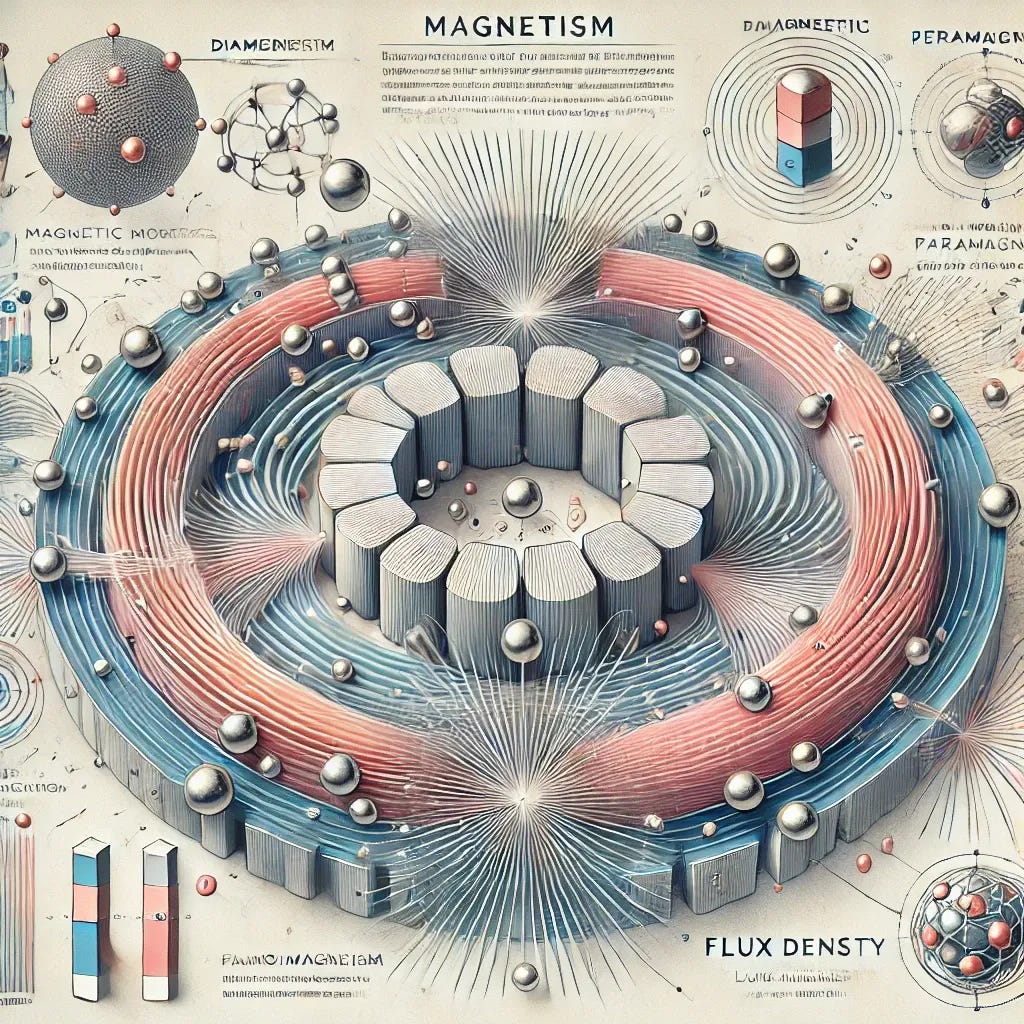Magnetic Properties and Their Role in Engineering and Material Science
A Comprehensive Overview of Magnetism from Magnetic Moments to Flux Density

Introduction
Magnetism is an intrinsic property observed in all materials, impacting how they respond to external magnetic fields. This theory of magnetism categorizes materials into distinct groups based on their magnetic behavior, which ranges from negligible to highly responsive. Understanding these properties is vital for engineering applications, from the design of magnetic storage devices to the development of electromagnetic machinery. This article delves into the characteristics of magnetic materials, their atomic-level magnetic moments, and the importance of magnetic flux and flux density in engineering applications.
Categorizing Magnetic Materials
In terms of magnetic response, materials can be classified into four main groups:
Nonmagnetic Materials: Materials like wood and rubber show negligible magnetic response and are practically unaffected by magnetic fields. They have no inherent magnetic moment, aligning their behavior with that of air or a vacuum.
Diamagnetic Materials: Diamagnetic substances, such as copper and silver, exhibit a slight opposition to magnetic lines of force. When placed in a magnetic field, these materials generate a weak magnetic field that opposes the applied field, causing them to be gently repelled from the magnet’s poles.
Paramagnetic Materials: Materials like aluminum and platinum slightly aid the passage of magnetic lines of force. Although their magnetic effects are weak, they align their magnetic fields in the same direction as the applied field, increasing the field’s strength in a subtle way.
Ferromagnetic Materials: These materials, which include iron, nickel, and cobalt, dramatically enhance magnetic fields. Ferromagnetic materials contain magnetic domains—regions where atomic magnetic moments are aligned. When exposed to an external magnetic field, these domains align in the same direction, producing a powerful, stable magnetic field.
Magnetic Moments and the Role of Electron Motion
A current-carrying conductor produces a magnetic field due to the motion of electrons, with magnetic fields forming circular flux lines around the conductor. Similarly, in atoms, electrons orbit the nucleus, creating what is called the magnetic moment of the electron.
Reinforcing and Opposing Magnetic Moments
When electrons in adjacent atoms orbit in the same direction, their magnetic moments reinforce each other, creating a cumulative magnetic field (see Figure 1(a)). However, if they orbit in opposite directions, their magnetic fields cancel out, resulting in a net zero magnetic flux (see Figure 1(b)). In nonmagnetic materials, the effects of orbiting electrons generally cancel each other out, while in magnetic materials, this alignment can lead to a significant net magnetic effect.
Magnetic Domains and Magnetization
In ferromagnetic materials, magnetic domains—a group of atoms with aligned magnetic moments—play a crucial role. When no external magnetic field is applied, the domains are randomly aligned, resulting in no net magnetic effect. However, when an external field is introduced, these domains align with the field, significantly amplifying the material’s magnetic response. The distinction between soft and hard magnetic materials is notable here:
Soft Magnetic Materials: These materials, such as soft iron, quickly lose their magnetization once the external field is removed.
Hard Magnetic Materials: Alloys like hard steel retain their magnetic domains’ alignment even after the external field is removed, creating a permanent magnet.
Magnetic Flux and Flux Density
Magnetic flux (Φ\PhiΦ) represents the total number of magnetic lines of force in a field, while flux density (BBB) is defined as the flux per unit area. The relationship between flux and flux density is expressed as:
B=ΦAB = \frac{\Phi}{A}B=AΦ
where BBB is measured in teslas (T), Φ\PhiΦ in webers (Wb), and AAA represents the cross-sectional area. Magnetic flux density decreases with distance from the magnet, as seen in the example of a bar magnet, where flux density is highest near the poles.
Example Calculation of Flux Density
Consider a bar magnet emitting a total flux of 2×10−4 Wb2 \times 10^{-4} \, \text{Wb}2×10−4Wb:
Within the Metal: If the cross-sectional area is 1 cm21 \, \text{cm}^21cm2:
B=2×10−4 Wb1×10−4 m2=2 TB = \frac{2 \times 10^{-4} \, \text{Wb}}{1 \times 10^{-4} \, \text{m}^2} = 2 \, \text{T}B=1×10−4m22×10−4Wb=2T
At a Distance: If the flux is spread over an area of 2 cm×2 cm2 \, \text{cm} \times 2 \, \text{cm}2cm×2cm:
B=2×10−4 Wb(2×10−2)2 m2=0.5 TB = \frac{2 \times 10^{-4} \, \text{Wb}}{(2 \times 10^{-2})^2 \, \text{m}^2} = 0.5 \, \text{T}B=(2×10−2)2m22×10−4Wb=0.5T
This example illustrates how flux density varies with both the material’s cross-sectional area and the distance from the magnetic source.
Engineering Applications of Magnetic Materials
Magnetic materials find extensive application in various devices, leveraging unique properties based on their type and behavior:
Static Forces: Holding devices, magnetic bearings, and clutches rely on stable magnetic fields for operation.
Electromagnetic Forces: Motors, loudspeakers, and other devices utilize electromagnetic interactions to produce controlled motion.
Electromagnetic Induction: Generators and sensors depend on changing magnetic fields to induce voltages.
Chemical Analysis and Medical Imaging: Magnetic resonance imaging (MRI) uses strong magnetic fields to visualize internal structures.
Key Takeaways
This overview highlights the diverse responses of materials to magnetic fields, ranging from nonmagnetic to ferromagnetic. The theory of magnetism provides a foundation for understanding how materials can be used and manipulated in practical applications. Whether for static holding devices, electric motors, or advanced diagnostic imaging, the magnetic properties of materials are central to innovations in modern technology.
References
Ahmad, Amna. "The Theory of Magnetism Explained." Amna Ahmad Journal, February 13, 2023.
Cullity, B. D., & Graham, C. D. Introduction to Magnetic Materials. Wiley-IEEE Press, 2008.
Coey, J. M. D. Magnetism and Magnetic Materials. Cambridge University Press, 2010.
O’Handley, R. C. Modern Magnetic Materials: Principles and Applications. Wiley, 2000.
This framework presents an in-depth look at the fundamentals of magnetism and its significance in engineering and scientific applications. Understanding these principles is essential for the continued development and utilization of magnetic materials in the industry.

